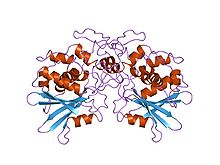리보솜불활성화단백질
Ribosome-inactivating protein| 리보솜불활성화단백질 | |||||||||||
|---|---|---|---|---|---|---|---|---|---|---|---|
 Pokeweed 항바이러스 [1]단백질 구조 | |||||||||||
| 식별자 | |||||||||||
| 기호. | RIP | ||||||||||
| 팜 | PF00161 | ||||||||||
| 인터프로 | IPR001574 | ||||||||||
| 프로 사이트 | PDOC00248 | ||||||||||
| SCOP2 | 1 paf / SCOPe / SUPFAM | ||||||||||
| |||||||||||
리보솜 불활성화 단백질(RIP)은 진핵생물 리보솜에서 [2]작용하는 단백질 합성 억제제이다.이 단백질군은 rRNA N-글리코실라아제(EC 3.2.2.22)로 작용하여 작용하는 그러한 단백질의 대군을 설명한다.그들은 28S rRNA의 [3][4][5]당-인산 골격에서 특정 아데닌 염기를 방출하는 N-글리코시드에 의해 60S 리보솜 서브유닛을 불활성화한다. RIPs는 [6]박테리아와 식물에 존재한다.
시가 독소, I형(트리코산틴 및 루핀 등) 및 II형(리신, 응집소, 압린 등) 리보솜 불활성화 단백질(RIPs)을 포함한다.이 모든 독소들은 구조적으로 관련이 있다.RIP는 암을 치료하기 위한 면역독소로 모노클로널 항체와 결합되어 잠재적인 사용으로 인해 상당한 관심을 받아왔다.또한 트리코산틴은 HIV-1에 감염된 T세포 및 [7]대식세포에 대해 강력한 활성을 갖는 것으로 나타났다.따라서 RIP의 구조-기능 관계에 대한 설명은 주요 연구 노력이 되었습니다.현재 RIP는 구조적으로 관련되어 있는 것으로 알려져 있습니다.보존된 글루탐산 잔류물은 촉매 [8]메커니즘에 관여하고 있으며, 이는 촉매 [9]작용에도 역할을 하는 보존된 아르기닌 근처에 있다.
RIP 중 극소수만이 섭취 시 사람에게 독성이 있으며, 쌀, 옥수수, 보리 등 인간의 소비에 사용되는 식물의 대부분에서 이 과의 단백질이 발견된다.식물에서, 그들은 병원균과 [10]곤충으로부터 방어하는 것으로 생각됩니다.
리보솜 불활성화 단백질(RIPs)은 단백질 도메인 [11]조성에 기초하여 다음과 같은 유형으로 분리된다.
- 타입 I(A): RIPs-I는 A 도메인으로 이루어진 폴리펩타이드입니다.N-글리코시다아제 활성 부위입니다.
- 타입 II(AB): RIPs-II는 타입 I RIPs와 유사한 촉매 활성을 가진 A 도메인과 탄수화물 결합(렉틴) 특성을 가진 B 도메인으로 구성된다.B 도메인은 세포 표면의 갈락토실 부분과 결합할 수 있으며, 이는 세포로의 진입을 용이하게 하여 타입 II를 특히 세포독성으로 만든다.A 도메인과 B 도메인은 디술피드 [11][12]결합에 의해 융합됩니다.시가독소 등 세균성 AB5 독소는 탄수화물 결합능력이 별도로 진화해 I형 RIP에 [11]더 가깝기 때문에 제외된다.
- 타입 III: RIP-II는 2개의 서브그룹으로 분할됩니다.1개의 서브그룹(AC)에는 같은 원래의 RIP 도메인(A)과 기능을 알 수 없는 C 단말기가 포함되어 있습니다.다른 부분군(AD)은 유형 I과 유사하지만 [11]불활성화 부위가 포함되어 있습니다.
예를 들어 다음과 같습니다.
- 아브린
- 비틴
- 리신
- 사포린
- 시가독소
- 스피로플라즈마[13] 독소
- 트리코산틴
- Viscumin(유럽 겨우살이)
- Pokeweed 항바이러스 단백질(Phytolacca Americana)[14]
레퍼런스
- ^ Monzingo AF, Collins EJ, Ernst SR, Irvin JD, Robertus JD (October 1993). "The 2.5 A structure of pokeweed antiviral protein". Journal of Molecular Biology. 233 (4): 705–15. doi:10.1006/jmbi.1993.1547. PMID 8411176.
- ^ 리보솜+미국 국립 의학 도서관(MeSH)의 비활성화+단백질 제목
- ^ Endo Y, Tsurugi K, Yutsudo T, Takeda Y, Ogasawara T, Igarashi K (January 1988). "Site of action of a Vero toxin (VT2) from Escherichia coli O157:H7 and of Shiga toxin on eukaryotic ribosomes. RNA N-glycosidase activity of the toxins". European Journal of Biochemistry. 171 (1–2): 45–50. doi:10.1111/j.1432-1033.1988.tb13756.x. PMID 3276522.
- ^ May MJ, Hartley MR, Roberts LM, Krieg PA, Osborn RW, Lord JM (January 1989). "Ribosome inactivation by ricin A chain: a sensitive method to assess the activity of wild-type and mutant polypeptides". The EMBO Journal. 8 (1): 301–8. doi:10.1002/j.1460-2075.1989.tb03377.x. PMC 400803. PMID 2714255.
- ^ Funatsu G, Islam MR, Minami Y, Sung-Sil K, Kimura M (1991). "Conserved amino acid residues in ribosome-inactivating proteins from plants". Biochimie. 73 (7–8): 1157–61. doi:10.1016/0300-9084(91)90160-3. PMID 1742358.
- ^ Mak AN, Wong YT, An YJ, Cha SS, Sze KH, Au SW, et al. (2007). "Structure-function study of maize ribosome-inactivating protein: implications for the internal inactivation region and the sole glutamate in the active site". Nucleic Acids Research. 35 (18): 6259–67. doi:10.1093/nar/gkm687. PMC 2094058. PMID 17855394.
- ^ Zhou K, Fu Z, Chen M, Lin Y, Pan K (May 1994). "Structure of trichosanthin at 1.88 A resolution". Proteins. 19 (1): 4–13. doi:10.1002/prot.340190103. PMID 8066085. S2CID 21524411.
- ^ Hovde CJ, Calderwood SB, Mekalanos JJ, Collier RJ (April 1988). "Evidence that glutamic acid 167 is an active-site residue of Shiga-like toxin I". Proceedings of the National Academy of Sciences of the United States of America. 85 (8): 2568–72. Bibcode:1988PNAS...85.2568H. doi:10.1073/pnas.85.8.2568. PMC 280038. PMID 3357883.
- ^ Monzingo AF, Collins EJ, Ernst SR, Irvin JD, Robertus JD (October 1993). "The 2.5 A structure of pokeweed antiviral protein". Journal of Molecular Biology. 233 (4): 705–15. doi:10.1006/jmbi.1993.1547. PMID 8411176.
- ^ Zhu, Feng; Zhou, Yang-Kai; Ji, Zhao-Lin; Chen, Xiao-Ren (9 February 2018). "The Plant Ribosome-Inactivating Proteins Play Important Roles in Defense against Pathogens and Insect Pest Attacks". Frontiers in Plant Science. 9: 146. doi:10.3389/fpls.2018.00146. PMC 5811460. PMID 29479367.
- ^ a b c d Lapadula WJ, Ayub MJ (September 2017). "Ribosome Inactivating Proteins from an evolutionary perspective". Toxicon. 136: 6–14. doi:10.1016/j.toxicon.2017.06.012. PMID 28651991. S2CID 9814488.
- ^ Fredriksson, Sten-Åke; Artursson, Elisabet; Bergström, Tomas; Östin, Anders; Nilsson, Calle; Åstot, Crister (December 2014). "Identification of RIP-II Toxins by Affinity Enrichment, Enzymatic Digestion and LC-MS". Analytical Chemistry. 87 (2): 967–974. doi:10.1021/ac5032918. ISSN 0003-2700. PMID 25496503.
- ^ Hamilton PT, Peng F, Boulanger MJ, Perlman SJ (January 2016). "A ribosome-inactivating protein in a Drosophila defensive symbiont". Proceedings of the National Academy of Sciences of the United States of America. 113 (2): 350–5. Bibcode:2016PNAS..113..350H. doi:10.1073/pnas.1518648113. PMC 4720295. PMID 26712000.
- ^ Domashevskiy AV, Goss DJ (January 2015). "Pokeweed antiviral protein, a ribosome inactivating protein: activity, inhibition and prospects". Toxins. 7 (2): 274–98. doi:10.3390/toxins7020274. PMC 4344624. PMID 25635465.


